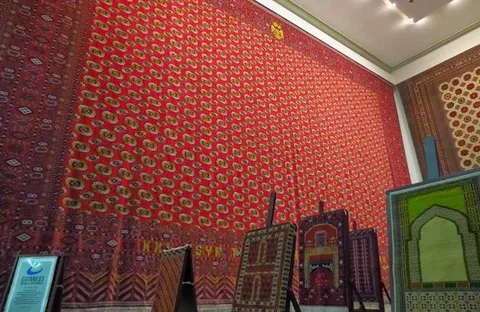The carpet in Turkmenistan is a state symbol. In order to preserve, revive and creatively develop the ancient traditions of Turkmen carpet weaving, the National Carpet Museum was established in 1993 by the decree of the President of Turkmenistan. It is located in the center of Ashgabat, near the State Association of Turkmenkhali.
There are no written sources and preserved evidence of where and when carpet weaving originated. However, there is clear evidence that carpets have been produced in Turkmenistan since ancient times.
Archaeologists working in the region have discovered devices dating back to the 4th to 3rd centuries BC that were used on looms. During excavations in the Sumbar Valley in the southwest of Turkmenistan, bronze carpet knives of the II century BC were discovered.
The first written sources about the famous Turkmen carpets can be found in Marco Polo, an Italian traveler who visited Eastern Europe and Asia around the 13th century AD. He praised Turkmen carpets, calling them “the thinnest and most beautiful in the world.”
Traditional carpet ornaments are even present on the national flag. On the vertical stripe of the Turkmen flag there are five main gels of the famous Turkmen carpets. These figures are arranged in a row, forming a pattern. Secondary forms are located along the edges. Golis reflect the national unity of Turkmenistan.
The circular stripe of the red circle of the State Coat of Arms of Turkmenistan depicts five main carpet gels clockwise: akhalteke, salyr, ersary, chovdur, yomut, which symbolize the friendship and cohesion of the Turkmen people. The total area of the museum is 15,000 sq.m. A third of this area is allocated for exhibition halls – 5000 sq.m. The exposition consists of 8000 exhibits, most of which date back to the XVII-XIX centuries. It presents the smallest carpet, in the form of a key holder and the largest, with an area of 301 sq.m., which is included in the Guinness Book of Records.
Turkmen carpets are famous all over the world. They, as before, are woven by hand. They are distinguished by beauty, strength, durability, and are an inexhaustible source of information thanks to the numerous speaking symbols embedded in their ornament.
Natural dyes and threads, as well as the warmth of human hands, saturate Turkmen carpets with powerful energy that attracts and fascinates. On the territory of the museum, in addition to the exhibition halls, there are exhibition halls, conference halls, production departments, warehouses, and, of course, the most important scientific department for the life of the museum. Its team is engaged in the study of the historical and artistic value of ancient carpets, as well as their scrupulous and careful restoration.
Visiting the National Museum of Turkmen Carpet, you will not only enjoy the beauty, patterns and play of colors, but also get closer to understanding the value of carpets, and feel the desire to read and unravel the symbols depicted on them.

